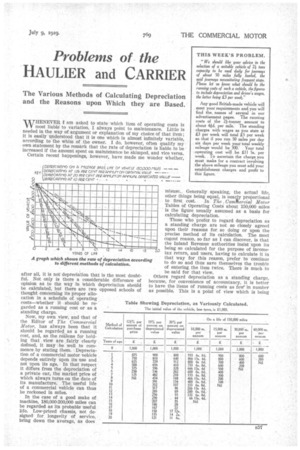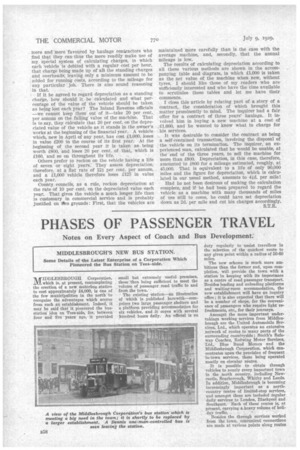Problems of the
Page 115

Page 116

If you've noticed an error in this article please click here to report it so we can fix it.
HAULIER and CARRIER
The Various Methods of Calculating Depreciation and the Reasons upon Which they are Based.
"WHENEVER I am asked to state which item of operating costs is most liable to variation, I always point to maintenance. Little is needed in the way of argument or explanation of my choice of that item ; it is easily understood that it is one which is almost infinitely variable, according to the whim of the owner. I do, however, often qualify ray own statement by the remark that the rate of depreciation is liable to be increased ff the amount spent on maintenance be skimped, and vice versa.
Certain recent happenings, however, have made me wonder whether, Now, my own view, and that of the Editor of The Commercial Motor, has always been that it should be regarded as a running cost, and, as the rea§ons for holding that view are fairly clearly defined, it may be well to commence by stating them. Depreciation of a commercial motor vehicle depends entirely upon its use and not upon its age. In that respect it differs from the depreciation of a private car, the market price of which always turns on the date of its manufacture. The useful life of a commercial vehicle can thus be reckoned in miles.
In the case of a good make of machine, 180,000-200,000 miles can be regarded as its probable useful life. Low-priced chassis, not designed for longevity of service, bring down the average, as does misuse._ Generally speaking, the actual life, other things being equal, is nearly proportional to first cost. In The ComThercial Motor Tables of Operating Costs about 150,000 miles is the figure usually assumed as a basis for calculating depreciation.
Those who prefer, to regard depreciation as a standing charge are not so closely agreed upon their reasons for so doing or upon the precise method of its calculation. The most cogent reason, so far as I can discover, is that the Inland Revenue authorities insist upon its being so calculated for the purpose of incometax return, and users, having to calculate it in that way for this reason, prefer to "continue to do so and thus save themselves the trouble of entering the item twice. There is much to be said for that view.
Others regard depreciation as a standing charge, because, for convenience of accountancy, it is better to have the items of running costs as fevir in number as possible. This is a point of view which is being
more and more favoured by haulage contractors who find that they can thus the more readily make use of my special system of calculating charges, in which each vehicle is debited with a regular cost per hour, that charge being made -up of all the standing charges and overheads, leaving only a minimum amount to be added for running costs, according to the mileage for any particular job. There is also sound reasoning in that.
If it be agreed to regard depreciation as a standing charge, how should it be calculated and what percentage of the value of the vehicle should be taken as being lost each year? The Inland Revenue officials —we cannot keep them out of it—take 20 per cent. per annum on the falling value of the machine. That Is to say, they calculate that 20 per cent. on the depreciated value of the vehicle as it stands in the owner's works at the beginning of the financial year. A vehicle which, new in April of any year, has cost 41,000, loses in value £200 in the course of its first year. At the beginning of the second year it is taken as being worth £800, and loses 20 per cent. of that, which is £160, and so on throughout its life.
Others prefer to reckon on the vehicle having a life of seven or eight years. They assess depreciation, therefore, at a flat rate of 12i per cent. per annum, and a £1,000 vehicle therefore loses 1125 in value each year.
County councils, as a rule, reckon depreciation at the rate of 10 per cent, on the depreciated value each year. That gives the vehicle a much longer life than is customary in commercial service and is probably justified on Om grounds: First, that the vehicles are maintained more carefully than is the case with the average machine, and, secondly, that the annual mileage is low.
The results of calculating depreciation according to all these various methods are shown in the accompanying table and diagram, in which £1,000 is taken as the net value of the machine when new, without tyres. I should like those of my readers who are sufficiently interested and who have the time available to scrutinize these tables and let me have their comments.
I close this article by relating part of a story of a contract, the consideration of which brought this matter prominently to mind. The inquirer had a fair offer for a contract of three years' haulage. It involved him in buying a new machine at a cost of £1,600, and he wanted to know what to charge for his services.
It was desirable to consider the contract as being a self-contained transaction, involving the disposal of the vehicle on its termination. The inquirer, an experienced man, calculated that he would be unable, at the end of the three years, to sell the machine for more than 1.800. Depreciation, in this case, therefore, amounted to £800 for a mileage estimated, roughly, at 45.000. That is equivalent to a life of only 90,000 miles and the figure for depreciation, which is calculated in our usual method, amounts to 4+,d. per mile!
Had he not been desirous of making the calculation complete, and ifhe had been prepared to regard the vehicle as a machine with many thousands of miles of use still to come, he could have set depreciation down as 2d. per mile and cut his charges accordingly.
S.T.R.
















































































































































































